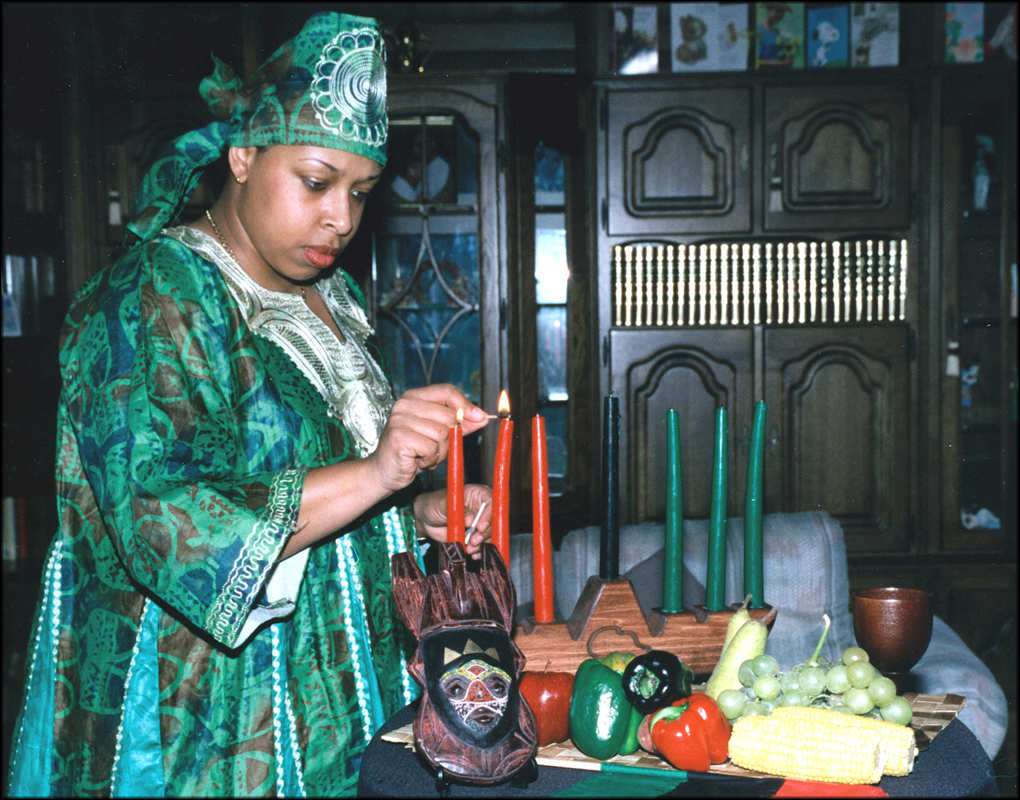Kwanzaa is an annual African American and pan-African celebration of family, community, and culture. It is observed between December 26 and January 1. It was created in 1966 by founder Dr. Maulana Karenga, in the wake of the 1965 Watts Rebellion, and is based on African harvest festival traditions, and the Swahili language. Dr. Karenga was a major figure in the Black Power and Civil Rights Movements, and his goal was to reaffirm African American roots in African culture; to serve as a communal celebration of African people to reaffirm and reinforce the bonds between them and to instill a sense of pride and identity, purpose, and direction.
Kwanzaa derives from the Swahili phrase “Matunda ya kwanza,” which means “first fruits.” Families who celebrate Kwanzaa decorate their homes with objects of African art, and colorful kente cloth, and display fresh fruits. During Kwanzaa celebrations, libations may be shared through a community cup and poured in remembrance of ancestors. The greeting for each day is “Habari Gani,” Swahili for “How are you?” and “Heri za Kwanzaa,” meaning “Happy Kwanzaa.” A communal feast called Karamu is held on the 6th day of the celebration.
Kwanzaa celebratory symbols include a mat, Mkeka, on which is placed a Kinara (candleholder) for Mishumaa Saba or seven candles; Mazao (fruits and vegetables); Muhindi (corn); Kikombe cha Umoja (unity cup); and Zawadi (gifts). Displays include books, a heritage symbol, and the red, black, and green bendera (flag). The seven principles of Kwanzaa, Nguzo Saba, are dedicated to the seven principles of African heritage. The candle (Mishumaa Saba) lighting ceremony called “Lifting Up the Light That Lasts,” is in conjunction with the seven principles, and are lit in a specific order each day of the celebration.
- Umoja (Unity) – To strive for and to maintain unity in the family community, nation and race. On the first day, the black candle, placed in the center, is lit, representing black people in unity.
- Kujichagulia (Self Determination) – To define ourselves, name ourselves, create for ourselves, and speak for ourselves. The red candle, on the left, nearest to the black is lit, which represents struggle.
- Ujima (Collective Work and Responsibility) – To build and maintain our community together and make our brothers and sisters problems our own and to solve them together. The green candle on the right, nearest to the black is lit, representing a fruitful future.
- Ujamaa (Cooperative Economics) – To build and maintain our own stores, shops, and other businesses and to profit from them together. The red candle on the left is lit.
- Nia (Purpose) – To make our collective vocation the building and developing of our community in order to restore our people to their traditional greatness. The green candle on the right is lit.
- Kuumba (Creativity) – To always do as much as we can, in the way we can, in order to leave our community more beautiful and beneficial than we inherited it. The red candle on the left is lit.
- Imani (Faith) – To believe with all our hearts in our people, our parents, our teachers, our leaders, and the righteousness and victory of our struggle. The green candle on the right is lit.
Former President Bill Clinton gave the first presidential declaration marking the holiday in 1993, and the first Kwanzaa stamp, designed by Synthia Saint James, was issued by the United States Post Office in 1997.


